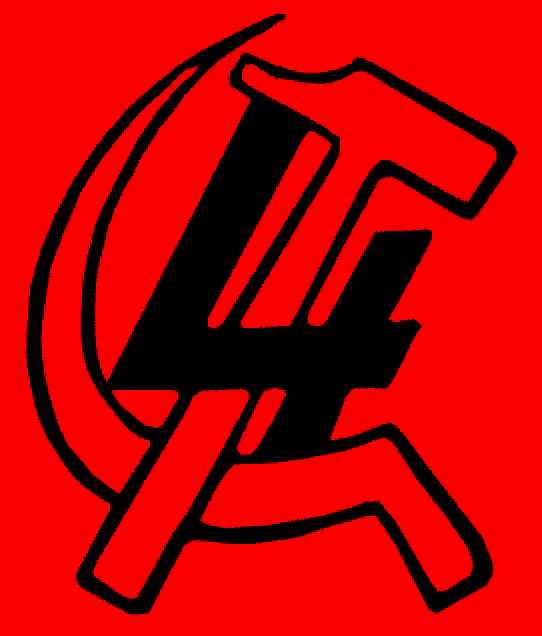
October 2006
GEM: Caboose of the Mexican Popular
Front
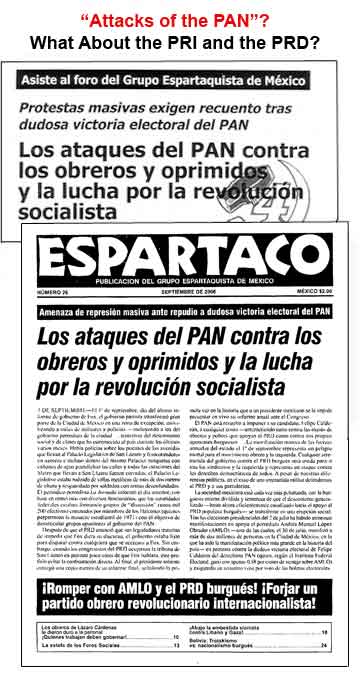 The
front page of Workers
Vanguard (18 September), published by the Spartacist League/U.S.,
is
headlined “Mexico in Turmoil.” The article is described as “translated
and
abridged from Espartaco,” the newspaper of the Grupo
Espartaquista de
México (GEM). But with a significant difference: the title of
the same lead
article in Espartaco (September 2006) reads: “The Attacks of
the PAN
Against the Workers and Oppressed and the Fight for Socialist
Revolution,”
referring to the rightist-clericalist National Action Party of Mexican
president Vicente Fox. This was also the title of a flyer for a forum
by the
GEM in Mexico City last August, along with a kicker: “Massive Protests
Demand
Recount After Dubious Electoral Victory of the PAN.”
The
front page of Workers
Vanguard (18 September), published by the Spartacist League/U.S.,
is
headlined “Mexico in Turmoil.” The article is described as “translated
and
abridged from Espartaco,” the newspaper of the Grupo
Espartaquista de
México (GEM). But with a significant difference: the title of
the same lead
article in Espartaco (September 2006) reads: “The Attacks of
the PAN
Against the Workers and Oppressed and the Fight for Socialist
Revolution,”
referring to the rightist-clericalist National Action Party of Mexican
president Vicente Fox. This was also the title of a flyer for a forum
by the
GEM in Mexico City last August, along with a kicker: “Massive Protests
Demand
Recount After Dubious Electoral Victory of the PAN.”
“The Attacks of the PAN…”
What’s missing from this picture? It’s a headline that should set off
alarm bells for any genuine revolutionary. The attacks on the working
class by the PRI
(Institutional Revolutionary Party), which ruled Mexico with a heavy
hand for
seven decades and still controls many state governments, and by the
populist
nationalist PRD (Party of the Democratic Revolution), which often poses
as a
friend of the working people – that’s what’s absent here. By focusing
on the
“attacks of the PAN,” to the exclusion of the other capitalist parties,
the Espartaco headline is a crude attempt to sidle up to the
huge numbers
of PRD
supporters who massively demonstrated and camped out for weeks in the
center of
Mexico City to protest apparent electoral fraud robbing their
presidential
candidate, Andrés Manuel López Obrador, of victory and
handing it to the PAN
candidate, Felipe Calderón.
For the past six months,
the Mexican working class has been the target of a series of murderous
assaults
by the forces of “law and order.” April 20: strikers occupying
the
Sicartsa steel mill in Lázaro Cárdenas, Michoacán,
attacked by 1,000 local,
state and federal police and marines; two workers executed. May 4:
Texcoco/Atenco, near Mexico City, flower sellers (!) arrested and their
defenders set upon by 3,000 local, state and federal police; two youths
murdered. June 14: striking teachers camped out in the state
capital of
Oaxaca attacked by an army of 3,500 riot police; in the aftermath, five
strike
supporters killed. The Mexican working class is under attack, all
right, but to
sum up these massacres as “attacks of the PAN” is a gross distortion,
and
ultimately a lie.
Politically, what’s most
noteworthy about this string of attacks is that, in every case, they
were
carried out by police under the orders of all three of the
major
capitalist parties. The PAN, the PRI and the PRD were competing with
each other
over who could crack down hardest against “insecurity.” The PRD
governor of
Michoacán sent state police against the steel workers; the PRD
mayor of Texcoco
sent municipal cops against the flower sellers; and PRD legislators in
Oaxaca
voted in advance for the use of “public force” by the PRI governor
against the
striking teachers. But you would hardly know this by reading the press
of the
GEM and the ICL. (In fact, the extensive article has not a word about
the role
of the PRD in unleashing repression in Atenco and Oaxaca, and the
barest
mention of Michoacán!)
“The Attacks of the PAN” – as a spokesman for
the League for the Fourth International remarked in an August 19 forum
of our Mexican section, the Grupo Internacionalista, attended by
virtually the entire membership of the GEM, this headline is
“a gift,” for it explodes the Trotskyist pretensions of the GEM and
reveals its real politics. This sleight of hand is a classic
opportunist gambit, where ostensible
revolutionaries rail against the most openly reactionary forces in
order to
justify veiled support for the supposedly “progressive” capitalist
party.
Similarly, opportunist leftists in the United States refer to the
invasion of
Afghanistan and Iraq as “Bush’s War,” thereby exonerating the
Democratic Party
which also supports the bipartisan imperialist war. The
generic name of
this strategem is “fight the right,” and it is a staple of Stalinist
and
social-democratic reformists who want to ingratiate themselves with the
masses
who follow a popular bourgeois party without openly supporting it.
Currently in the U.S., in
the lead-up to the 2006 mid-term Congressional elections, the
Maoist-Stalinists
of the Revolutionary Communist Party (RCP) – via their front group, The
World
Can’t Wait – are holding marches to “Drive Out the Bush Regime” that
are
explicitly geared to attract “disappointed Democrats.” Another
variation on the
same theme is a conference by the social-democratic International
Socialist
Organization (ISO) titled “Build the Left, Fight the Right.” Yet
despite the
“socialist” and even “communist” references in the names of the
sponsors, these
are all placed in the left-right framework of bourgeois
politics. By
singling out the Republican right, they are implicitly (and
deliberately)
appealing to “left” Democrats. Ditto for references to the “Attacks of
the PAN”
in Mexico.
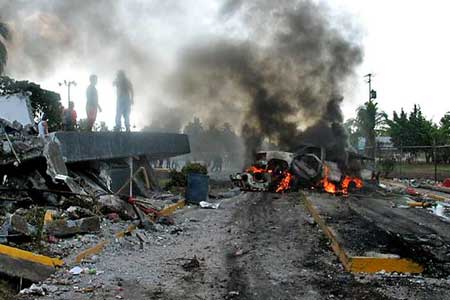 “Attacks of the PAN”?
In Lázaro Cárdenas, Michoacán, police forces under
the command of PAN (federal), PRI (local) and PRD (state) all
participated in assault on strikers occupying Sicartsa steel plant; two
workers were executed.
“Attacks of the PAN”?
In Lázaro Cárdenas, Michoacán, police forces under
the command of PAN (federal), PRI (local) and PRD (state) all
participated in assault on strikers occupying Sicartsa steel plant; two
workers were executed.
(Photo: Arnulfo
Mora/Quadratin)
In the United States, this
ploy was made famous by the Communist Party in the 1936 presidential
election
when the CP ran its own pro forma presidential candidate (Earl Browder)
while
telegraphing to its supporters to vote for Democrat Franklin D.
Roosevelt in
the name of “combating this reactionary bloc [of the Republican right
wing] and
defeating its plans.” Declaring that a “People’s Front … will develop
in the
form of progressive movements inside and around the Democratic Party,”
the CP
denounced the attacks of the right on the workers, while remaining
silent about
the attacks by FDR.
The popular front is a
class-collaborationist coalition chaining the mass organizations of the
working
class to sectors of the class enemy by means of an alliance with
bourgeois
parties and politicians. In the Spanish Civil War of 1936-39, the
Chilean
Unidad Popular government of 1970-73 and elsewhere, Stalinist and
social-democratic reformists have erected popular fronts as dikes to
hold back
the struggle of the workers until it comes time for a Franco or
Pinochet to
massacre them. And for nearly two decades, as the decaying one-party
regime of
the PRI-government has come apart, Mexico’s capitalist rulers (and
their U.S.
imperialist patrons) have required a popular front to act as a
roadblock to
revolution. Today they need it more than ever.
The ICL has been moving to
the right for some time, moving from abstention from the class struggle
to
abandonment of key programmatic tenets of Leninism and Trotskyism. Its
dysfunctional Mexican section, under orders from its center, sat out
most of
the 1999-2000 National University (UNAM) strike and has been next to
invisible
in four months of labor insurgency in Oaxaca. But in the heat of the
convulsive
class battles that have shaken Mexico this year, their torturous
formulas have
led them to imitate classical popular-front politics, and worse. In
attempting
to force an American framework on semi-colonial Mexico, pretending that
the
corporatist labor bosses appointed by the capitalist state are just a
bunch of
sellout union bureaucrats like the Teamsters’ Jimmy Hoffa, they end up
apologizing for “labor” death squads that are literally killing
strikers.
The “Fantasmagorical”
Popular Front
In Mexico, ever since the
political apertura (opening) in the late 1970s and early ’80s
when the
PRI regime tried to disguise its single-party rule by providing more
space for
token opposition candidates, large-scale electoral fraud has been the
way
right-wing forces have kept a lock on power. Cuauhtémoc
Cárdenas was probably
robbed of victory in 1988 by a highly suspicious “crash” of the
electoral
computer system in the midst of the vote counting. At the time, various
ostensibly Trotskyist groups which hadn’t openly called for votes to
Cárdenas
jumped on the cardenista bandwagon calling to “defend the
vote.” The PRT
(Revolutionary Workers Party, Mexican followers of Ernest Mandel), for
example,
called to “support the people in the active legal defense of their
vote.”
In the aftermath of the
recent (July 2) Mexican presidential election, up to 2 million people
came out
at the call of PRD standard-bearer López Obrador, widely known
by his initials
AMLO, to protest election fraud. For six weeks, a huge megaplantón
(encampment) of AMLO supporters occupied the Zócalo, Mexico
City’s central
plaza, and several miles of the elegant main avenue, Paseo de la
Reforma.
Various pseudo-Trotskyists such as the Militante group (which claims to
be the
“Marxist” wing of the bourgeois PRD!) and what remains of the PRT
(which called
to vote for AMLO) joined the plantón. Others like the
LUS (Socialist
Unity League) and LTS (Socialist Workers League) which didn’t formally
call to
vote for AMLO quickly climbed aboard the “anti-fraud” train.
Bringing up the rear was
the Grupo Espartaquista. Like the LUS and LTS, it did not call for
votes to the
PRD. But while limply declaring that “we do not oppose a vote-by-vote
recount,”
the GEM maintains a fig leaf of independence, saying “we are not
joining the
current PRD campaign, whose objective is to put López Obrador in
power.” At the
same time, in order to gain favor with the followers of AMLO, Espartaco
tilts toward the PRD with headlines on “The Attacks of the PAN….” To
back up
their tilt, they argue: “The exploited and oppressed masses of Mexico
have
shown that they want to struggle, but they presently
regard the
bourgeois PRD and AMLO as their representatives.” And then they launch
a
lengthy polemic against the Grupo Internacionalista, saying: “The GI is
incapable of dealing with the fact that the workers see the bourgeois
PRD as their leadership.”
How so? Espartaco
writes: “According to them [the Grupo Internacionalista], the principle
obstacle in Mexico to workers revolution is a fantasmagorical ‘popular
front’
around the PRD.” The tiny Grupo Espartaquista may not “recognize” the
popular
front in Mexico, but precisely because of its willful denial of this
reality,
the GEM has been sucked into the wake of the political alliance that
chains
large sections of the working class to the bourgeois populist candidate
López
Obrador and his party. The Grupo Internacionalista, in contrast, fights
to
break the workers and oppressed from the AMLO pop front.
Going back to the 1988
election, a popular front coalesced around the candidacy of
Cuauhtémoc Cárdenas
to siphon off the burgeoning workers’ resistance to the starvation and
privatization policies implemented by the PRI government on behalf of
Wall
Street and Washington. Over the years, this front tied various
“independent”
unions to the PRD, which was founded by Cárdenas supporters from
the PRI and a
panoply of leftist groups headed by the remnants of the now defunct
Communist
Party of Mexico. The popular front was not limited to electoral support
but
also took the form of various coalitions against privatization, for
national
dialogue, against neo-liberalism, for democratic transition, etc.
including the
same cast of “independent” unions and AMLO’s Party of the Democratic
Revolution.
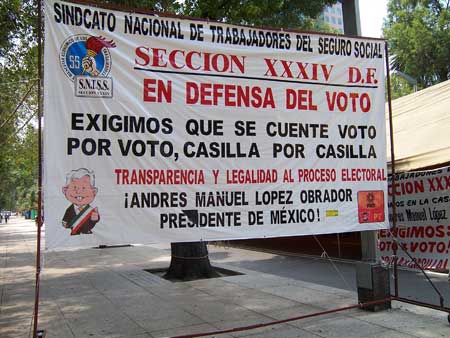 No popular front in Mexico? “Independent” unions were
heavily present in giant PRD plantón
(encampment) in Mexico City for six weeks this summer. Here: the Social
Security Workers Union (SNTSS). (Internationalist photo)
No popular front in Mexico? “Independent” unions were
heavily present in giant PRD plantón
(encampment) in Mexico City for six weeks this summer. Here: the Social
Security Workers Union (SNTSS). (Internationalist photo)
Far from being
“fantasmagorical,” the popular front around the PRD could be seen
graphically
in the streets of Mexico City of late. In the megaplantón along
Reforma
there was one tent after another of the SNTSS (National Union of Social
Security Workers), STUNAM (National University Workers Union), SITUAM
(Union of
Workers of the Autonomous University of Mexico), CNTE (National
Coordinating
Committee of Educational Workers), SUTIN (nuclear workers), National
Bottlers
Union, Union of Workers of the Federal District, National Alliance of
Democratic Oil Workers, Trade Unionists for Democracy, etc., many with
their
union symbols next to that of the “Coalición por el Bien de
Todos” (Coalition
for the Good of All), the electoral vehicle for AMLO’s candidacy (see
photos).
If that were not enough, on
September 16 the mammoth National Democratic Convention in Mexico
City’s Zócalo
called by López Obrador proclaimed a Broad Progressive Front
(FAP – Frente
Amplio Progresista) including the PRD and the PT (Party of Labor, a
minor
bourgeois party set up by the PRI to harvest workers votes and now
aligned with
AMLO), with the support of the SME (electrical workers), the STRM
(telephone
workers), and various unions affiliated to the overlapping labor
federations
UNT (National Workers Union), FSM (Mexican Labor Federation) and FNUAS
(National Front for Trade-Union Unity and Autonomy). The popular front
around
the PRD is not only very much alive, it is a principal obstacle to
victory for
the Oaxaca strike as leaders of the teachers’ union (Section 22 of the
SNTE/CNTE) and the Popular Assembly of the People of Oaxaca (APPO) have
given
“tactical” political support to the PRD.
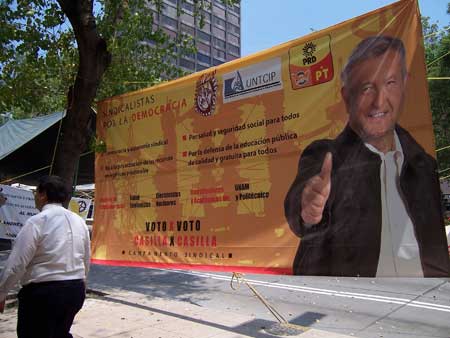 More
union banners in PRD megaplantón.
Note union symbols next to that of the PRD-led Coalition for the Good
of All. (Internationalist photo)
More
union banners in PRD megaplantón.
Note union symbols next to that of the PRD-led Coalition for the Good
of All. (Internationalist photo)
For almost a decade after
1988, from its very inception the GEM called on Mexican workers to
break from
the popular front around Cárdenas and the PRD. Today it does
not. Why not? Espartaco argues, “The GI invokes the existence
of a popular front
around the PRD to
prettify the present consciousness of the working class, denying the
fundamental ideological obstacle of bourgeois nationalism and illusions
in the
democratic reform of the capitalist state.” According to the contorted
reasoning of the ICL, calling on Mexican workers to break from a
popular front
would “prettify” their consciousness because they are so besotted with
bourgeois nationalism and democratic illusions that it doesn’t matter
that
their mass organizations are chained to a class-collaborationist
coalition.
And let’s not forget Roman
Catholicism. According to Workers Vanguard and Espartaco,
“undoubtedly the majority of those who support the PRD also identify,
in one
degree or another, with some of the reactionary Catholic values that
the PAN
prominently pushes.” On what basis have these self-appointed experts in
religious sociology made this determination? Never mind the long
tradition of
bourgeois anti-clericalism in Mexico, or that PRD supporters repeatedly
clashed
with Cardinal Norberto Rivera at the doors of the Metropolitan
Cathedral on the
edge of the Zócalo. When you add it all up – nationalism,
democratic illusions,
Catholicism – for the ICL, Mexican workers are just too damn backward
to have a
popular front. This is imperialist arrogance masquerading as Marxism.
“The mass of workers and
radicalized youth who participate in defensive struggles no longer
identify
with the ideals of communism,” pontificates the spokesman of the GEM,
even as
red flags proliferate in Oaxaca. This is what the bourgeois press said
over and
over about the French youth revolt last spring, and it is a mantra that
the ICL
has been repeating all over the world in order to justify their
abstentionist
policies. These deserters from Trotskyism claim that the key thesis of
Leon
Trotsky’s Transitional Program – that the historical crisis of humanity
is
reduced to the crisis of proletarian leadership – is outdated, because
it
supposedly “predates the present deep regression of proletarian
consciousness”
with the destruction of the Soviet Union. At issue now is not so much
the
leadership but “the working classes across the world,” dixit the ICL in
its
revised “Declaration of Principles and Some Elements of Program”
(1998).
In Bolivia, where
worker-peasant uprisings toppled two governments in two years, the ICL
goes so
far as to assert that the Internationalist Group and League for the
Fourth
International “conjure up a proletariat where it barely, if at all,
exists”
(see “Spartacist League Disappears the Bolivian Proletariat,” The
Internationalist No. 24, Summer 2006 for our refutation of this
anti-Marxist idiocy). In the ICL’s idealist fantasyland, the Bolivian
workers’
consciousness evidently regressed so far that they ceased to exist as a
class.
We are waiting with baited breath for the GEM to inform us that in
there is no
working class in Oaxaca as well, where the GEM has been notably absent
in three
months of a convulsive teachers strike (except for a brief foray as
part of a national
student congress).
The other main argument of
the GEM/ICL for why there is not and cannot be a popular front in
Mexico is
that there is no mass workers party. The popular front “refers to the
political
subordination of the mass parties of the working class to the
capitalists,”
decrees the ICL. “In Mexico, such a party of the working class has
never
existed, not even a reformist bourgeois workers party in the style of
British
Labourism.” So since Mexican workers have been incapable of producing a
Labour
Party, they can’t have a popular front either. But the entire premise
is false.
Where did Trotsky, author of the definitive Marxist analysis of popular
frontism, declare that popular fronts are limited to mass workers
parties?
Let’s take a look. In a
January 1939 discussion on Latin America, Trotsky referred to the
Guomindang
(KMT) of Chinese dictator Chiang Kai-shek, Lázaro
Cárdenas’ Party of the
Mexican Revolution (PRM, precursor of the PRI) and Haya de la Torre’s
American
Popular Revolutionary Alliance (APRA) – all of them bourgeois parties –
as “the
People’s Front in the form of a party.” And the Manifesto of the Fourth
International on “Imperialist War and the Proletarian World Revolution”
(May
1940) declares:
“But in the colonial and
semi-colonial countries not only in China and India, but in Latin
America – the
fraud of the ‘People’s Fronts’ still continues to paralyze the working
masses,
converting them into cannon fodder for the ‘progressive’ bourgeoisie
and in
this way creating an indigenous political basis for imperialism.”
In none of
these countries – not in China, India or anywhere in Latin America –
were there
mass workers parties at the time Trotsky wrote these lines. For that
matter,
the ICL for decades referred to popular fronts in El Salvador, Algeria,
South
Africa and elsewhere in semi-colonial countries where there were no
mass
workers parties. The latter-day ICL’s redefinition of the popular
front,
denying its applicability to most of the so-called “Third World,” was
invented
to attack the Internationalist Group (see “Declaration of the Permanent
Revolution Faction,” The Internationalist No. 5, April-May
1998).
But the issue is not just
semantic, a dispute over definitions. At bottom, what’s at stake is
whether
revolutionaries fight for working-class independence from the class
enemy. The
Grupo Internacionalista and the League for the Fourth International
call on
Mexican workers to break with the bourgeois popular front around the
PRD. The
Grupo Espartaquista and the ICL do not, on the spurious grounds that to
do so
would “prettify” the consciousness of the Mexican workers. These
pseudo-Trotskyists dismiss the powerful Mexican proletariat as
hopelessly mired
in nationalism and Roman Catholicism, rather than intervening in the
class struggle
to break the organizational and ideological chains of subjugation.
GEM: “CTM Socialists”…
A second theme of the Espartaco/Workers
Vanguard attack on the Grupo Internacionalista and the League for
the
Fourth International is the GEM/ICL’s shameless apology for the
corporatist
pseudo-unions in Mexico. These instruments of state control of labor
are
inherited from the semi-bonapartist regime of the Institutional
Revolutionary
Party which ran Mexico from 1929 to 2000. Beginning under the rule of
Plutarco
Elías Calles, the PRI and its predecessors erected a corporatist
regime,
borrowing organizational forms from Mussolini’s Italy. (The 1931
Federal Labor
Code was literally modeled on its Italian fascist counterpart.) But in
semi-colonial countries with weak national bourgeoisies, the political
content
of these forms varied, as capitalist governments often have what Leon
Trotsky
called a “bonapartist sui generis” (unique or distinctive)
character.
That is, they can govern by chaining the workers under a police
dictatorship or
they may maneuver between the imperialists and a relatively strong
proletariat,
even offering concessions to the workers (like Mexico’s oil and rail
nationalizations).
When the PRI-government was
at the height of power, virtually everyone in the country was enrolled
in the
multiple mass organizations that were organically part of the state
party.
Peasants were part of the CNC (National Peasant Federation); youth were
part of
the CJM (Mexican Youth Federation); small businessmen were part of the
CNOP
(National Confederation of Popular Organizations); women were part of
Mujeres
Revolucionarias; architects were part of the Arquitectos
Revolucionarios, and
so on. When combative workers unions arose in the mid-1930s, the
populist-nationalist president Lázaro Cárdenas moved to
co-opt them by setting
up the Mexican Workers Federation (CTM), which became part of the Party
of the
Mexican Revolution (PRM – predecessor to the PRI). Describing a
worldwide
tendency toward state control of labor, Trotsky wrote in his unfinished
essay
“Trade Unions in the Epoch of Imperialist Decay” (August 1940):
“In Mexico the trade
unions have been transformed by law into semi-state institutions and
have, in
the nature of things, assumed a semi-totalitarian character. The
stateization
of the trade unions was, according to the conception of the
legislators,
introduced in the interests of the workers in order to assure them an
influence
upon the governmental and economic life. But insofar as foreign
imperialist
capitalism dominates the national state and insofar as it is able, with
the
assistance of internal reactionary forces, to overthrow the unstable
democracy
and replace it with outright fascist dictatorship, to that extent the
legislation relating to the trade unions can easily become a weapon in
the
hands of imperialist dictatorship.”
Evolving from semi-state
institutions under Cárdenas, during the course of World War II
and through the
post-war “red purges” carried out at the behest of the U.S. government,
the CTM
unions became thoroughly integrated into the capitalist state. By the
1950s,
quantity had turned into quality. Union leaders were henceforth named
directly
by the PRI-government, labor militants (not only Communists) were fired
by the
thousands and many jailed for years, the CTM “labor” federation engaged
in
systematic strikebreaking and maintained squads of pistoleros
to
assassinate union oppositionists on a mass scale. Over the next half
century,
virtually every major labor struggle in Mexico (teachers in 1956-58,
railroad
workers in 1958, electrical workers in 1976-76, garment workers in the
mid-1980s, miners and steel workers in 1989, maquiladora [free trade
zone]
workers from 1983 on) has been directed against the charro (corporatist) “sindicatos”
which
claimed to represent the workers but were actually labor cops for the
bourgeoisie.
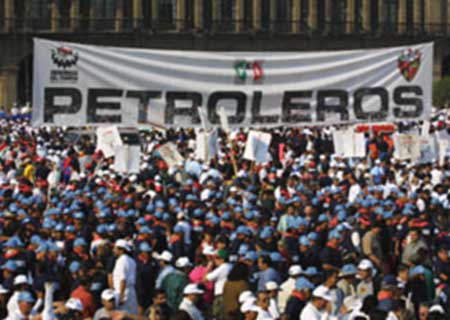 Contingent
of corporatist oil workers union in 2003 May Day march. Symbols of
Congress of Labor (left), PRI (center) and oil workers union.
(Photo: Reforma)
Contingent
of corporatist oil workers union in 2003 May Day march. Symbols of
Congress of Labor (left), PRI (center) and oil workers union.
(Photo: Reforma)
The fundamental
characteristic of corporatist “unions” is that they are part the
machinery of a
corporatist bourgeois regime which regiments every sector of society,
sometimes
buying popular support by throwing some crumbs to labor rather than
simply
repressing workers as under the Pinochet dictatorship. Such corporatist
apparatuses are not unique to Mexico, but can be found in a number of
semi-colonial and intermediate capitalist countries with bonapartist
and
semi-bonapartist regimes. In Algeria and other African countries where
a
single-party regime arose after independence, there were similar labor
groups
among the mass organizations of the state party. As the single party
loses its
control, its labor apparatuses are thrown into crisis and independent
unions
are thrown up or break away.
In Argentina under Juan
Domingo Perón from the mid-1940s to the early ’50s, another
example of a
bonapartist sui generis regime such as Trotsky analyzed in
Cárdenas’
Mexico, workers unions led by Communists, socialists and anarchists
were taken
over or destroyed and replaced by labor organizations under the control
of the
government labor department. Likewise, in Brazil under Getulio Vargas
in the
1930s and ’40s and again under the 1964-1985 military dictatorship
there were
corporatist government-controlled “unions,” which gave rise to huge
struggles
for independent unions. Our comrades of the Liga
Quarta-Internacionalista do
Brasil participated in the 1980s strikes and in the early years of the
Workers
Party (PT) which grew out of them, while opposing the PT-led popular
front from
1989 on, which in 2002 made
ex-corporatist labor faker Luiz Inácio Lula da Silva president
to dismantle
workers’ gains.
The ICL and its Mexican
offshoot refuse to recognize this in large part because they seek to
force the
Mexican reality into the framework of American trade-unionism, derived
from an
imperialist economy which occasionally throws some crumbs to a labor
aristocracy. Corporatist unions such as in Mexico, Argentina, Brazil
and
Algeria have never existed in the U.S., nor could they in any
imperialist
country, except under a fascist/bonapartist dictatorship. On the other
hand, a
Labor Party on the British model is well-nigh impossible to build in an
impoverished semi-colonial capitalist country, yet popular-fronts and
popular-frontism can be found in most “Third World” countries that have
a
proletariat.
The issue of corporatism
underlies the recent mine and metal workers’ strikes in Mexico. In late
February, after a mine disaster at Pasta de Conchos in the state of
Coahuila in
which 65 miners were buried alive, the charro “union” leader,
Napoleón
Gómez Urrutia, under pressure from the survivors and families,
criticized the mine
operator, Grupo Mexico, of “industrial homicide.” Gómez Urrutia
is a lawyer who
inherited the leadership of the National Union of Mining and
Metallurgical
Workers of Mexico (SNTMMRM) from his father, Napoleón
Gómez Sada, and was
installed by the federal labor ministry in 2001. But the Fox
government,
closely tied to the mine bosses, would not brook any criticism by its
puppet
“union” chief, so it dumped “Napito” in favor of a more pliant pawn,
Elías
Morales. This unleashed a national strike involving several hundred
thousand
mine and steel workers.
The SNTMMRM is no defender
of the workers. It was co-responsible for the Pasta de Conchos miners’
deaths,
having routinely signed off on the safety inspections in the
notoriously unsafe
mines. Relatives told reporters that the union and the company “are the
same
thing.” The government-installed “union” chief Gómez Urrutia was
no less an
instrument of the bosses than his government-installed replacement,
Morales.
But all class-conscious workers would object to the attempt by the
capitalist
state to name and remove leaders of what claim to be labor unions. The
Grupo
Internacionalista defended the miners’ strikes and urged other sectors
of the
working class to go out on a national strike against all government
interference
and for class independence from the bosses. At the same time, the GI
called for
the formation of independent workers committees to break with
corporatism and
forge class-struggle unions (see “Capitalist Murder in Pasta de
Conchos,” El
Internacionalista/Edición México No. 2, August 2006).
The SNTMMRM chief called
the strikes off after a couple of days, leaving some of the most
militant
locals (Sicartsa in Michoacán, Cananea, Agua Prieta and Nacozari
in Sonora,
Sombrerete in Zacatecas) to go it alone. Under Gómez Sr.,
strikes by these same
locals were repeatedly sabotaged by the national “union.” Yet the GEM
now
declares: “The GI didn’t even defend the miners union against state
attack! In
accordance with its adaptation to the PRD, this group claims that the
unions
affiliated with the PRI – like the miners union – are not workers
organizations, but the ‘class enemy’ (El
Internacionalista/Edicion México No. 1, May 2001).” The Espartaco
article
goes on to say that this “would also apply to the SNTE and its Section
22 in
Oaxaca.” It conveniently doesn’t mention that the Oaxaca teachers
themselves
have been in revolt for years against the national SNTE
(National Union
of Education Workers), which has emphatically opposed the Oaxaca
strike, is
financing a group (the CCL) that is scabbing, and now supports sending
federal
police and troops against the strikers. Interestingly, the CCL is led
by prominent supporters of the Oaxaca PRD,
whose leaders have also called for sending federal forces to smash the
strike.
…. Become Apologists
for
Death Squads
The decay of the
corporatist system of the PRI is behind the explosive struggle by the
Oaxaca
teachers. The president of the national “union,” the SNTE, Elba Esther
Gordillo, was appointed by the Secretary of Government at an all-night
meeting
in the secretariat, after her predecessor (Carlos Jonguitud, also a PRI
flunkey) had been “resigned” hours earlier in a meeting with President
Carlos
Salinas de Gortari. Between them, Gordillo and Jonguitud are
responsible for
ordering the assassination of more than 150 SNTE dissidents. Lately,
with the
PRI’s power eclipsed, Gordillo transferred her institutional
allegiances to the
Fox regime, and set up a new “party,” the PANAL (National Alliance
Party), to
support the PAN candidate Calderón.
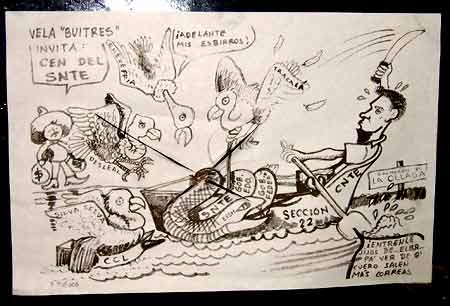 Section
22, on the other
hand, is a key component of the breakaway CNTE (Coordinating Committee
of
Education Workers), which grew out of a revolt by teachers in Oaxaca
and
Chiapas 20 years ago. In many ways, the CNTE and Section 22 function as
a
separate union, calling statewide teachers strikes and national
mobilizations
of up to 500,000 teachers, directed against the national SNTE and the
government’s
Education Secretariat where SNTE chief Gordillo & Co. generally
select
personnel and set policy. In the current Oaxaca strike, one can see
numerous
cartoons lambasting the national union, such as the one shown here
portraying
the SNTE, state and federal governments as a serpent headed by Gordillo
(EEGM)
while Section 22 and the CNTE are rowing the boat and fending off the
vultures
such as the CCL scabs egged on by the national SNTE leadership.
Section
22, on the other
hand, is a key component of the breakaway CNTE (Coordinating Committee
of
Education Workers), which grew out of a revolt by teachers in Oaxaca
and
Chiapas 20 years ago. In many ways, the CNTE and Section 22 function as
a
separate union, calling statewide teachers strikes and national
mobilizations
of up to 500,000 teachers, directed against the national SNTE and the
government’s
Education Secretariat where SNTE chief Gordillo & Co. generally
select
personnel and set policy. In the current Oaxaca strike, one can see
numerous
cartoons lambasting the national union, such as the one shown here
portraying
the SNTE, state and federal governments as a serpent headed by Gordillo
(EEGM)
while Section 22 and the CNTE are rowing the boat and fending off the
vultures
such as the CCL scabs egged on by the national SNTE leadership.
To “defend” the SNTE and
the other charro “unions” as
the GEM does is to defend strikebreaking, and
worse: murdering strikers. As a militant of the Grupo Internacionalista
explained to the GEM membership attending our August 19 forum at the
Museo León
Trotsky, the main corporatist “union” present in Oaxaca City is the
CROC
(Revolutionary Federation of Workers and Peasants, in which the
“Revolutionary”
refers to its affiliation with the PRI). The CROC was set up some
decades ago
to provide a more militant face for the increasingly discredited CTM.
But now
it is gyrating wildly, siding with the PRD when it looked like AMLO
would win
the presidency, going over to the PAN after Calderón was
declared victor, and
acting as an instrument for PRI governors in several states. In Oaxaca,
the
CROC is a key component of the still-intact PRI regime which has ruled
the
state uninterruptedly for three quarters of a century. At the behest of
PRI
governor Ulises Ruiz, the CROC called a “strike” in December 2004
against the
newspaper Noticias, the only local media to oppose Ruiz and
support the
teachers. Although the “strikers” didn’t even work at the paper, the
government
recognized their strike and a tent with CROC thugs has shut down the
paper’s
office ever since.
CROC goons have been an
ever-present menace, and now they have launched death squads against
the
strikers. On the night of August 21-22, after the Oaxaca state attorney
general
denounced the teachers strike as “urban guerrillas,” the police mounted
an
operation to “clear the streets.” This involved a caravan of several
hundred
gunmen in 34 vehicles, which careened through the city shooting wildly
at
strikers’ barricades and encampments. Two teachers were badly burned
when they
and their vehicle was torched by the gun thugs, several photographers
were
fired on, and an architect, Lorenzo San Pablo Cervantes, was shot to
death. The
CROC was an integral part of this “convoy of death.” La Jornada
(23
August) reported:
“The ‘mopping up’
operation was joined by several pick-up trucks filled with goons and
gunmen of
the CROC, whose leader is David Aguilar; they drove around menacingly,
at very
high speed…. People took it upon themselves to cut them off by erecting
new
barricades and isolating them.”
Noticias (23 August) also noted the presence of the
CROC:
 “Thugs riding on pick-up
trucks and SUVs, led by members of the CROC, also joined the officers
from
different police forces in their attack. In the face of this, residents
of
various neighborhoods and suburbs came into the streets and surrounded
the
radio station to join the defense and set up barricades with city
buses, tires,
rocks, sticks and other objects to prevent another attack.
“Thugs riding on pick-up
trucks and SUVs, led by members of the CROC, also joined the officers
from
different police forces in their attack. In the face of this, residents
of
various neighborhoods and suburbs came into the streets and surrounded
the
radio station to join the defense and set up barricades with city
buses, tires,
rocks, sticks and other objects to prevent another attack.“Residents of other
projects did the same in streets and avenues to try and surround the
aggressors. Around 2:50 a.m., part of the police convoy … in the
suburban town
of Santa Cruz Xoxocatlán was surrounded by members of the
teachers’ and popular
movement. The police fired on them, although there were no reports of
wounded.”
 Above: Gunmen from the
corporatist “labor” federation CROC participated in the “convoy
of death” which drove around Oaxaca in late August shooting and killing
strikers. Below: Strikers set up barricades to stop police/CROC death
squads.
Above: Gunmen from the
corporatist “labor” federation CROC participated in the “convoy
of death” which drove around Oaxaca in late August shooting and killing
strikers. Below: Strikers set up barricades to stop police/CROC death
squads.(Photos: Jorge Luis Plata/Reforma)
And it’s not just the CROC.
During a September 28 lockout called by the Oaxaca employers’
federation, there
were plans to stage provocations which could then serve as an excuse
for
federal military and police intervention. La Jornada (29
September)
obtained detailed plans for the operation, which include the following:
“Four groups
of PRI members affiliated to the CROC and the CTM, as well as police
and
municipal employees, are ready to attack businesses and passers-by,
kidnap and
burn vehicles, attack the population and news media, passing themselves
off as
members of the APPO.” The only reason this didn’t take place is that
the
lockout was a miserable flop, with barely 10 percent of the businesses
shutting
down.
So when we insist that the
corporatist so-called “labor” federations are not workers unions, but
labor
cops for the bosses and the capitalist government, this is no abstract
question. They are literally on the other side of the barricades,
firing on the
strikers and dousing them with gasoline to burn them alive, organizing
scabbing
and seeking by every means to break the strike. This is what the GEM is
defending and alibiing when it says it “defends the unions” like the
SNTE, CTM
and CROC. During the GEM’s brief foray into Oaxaca during the student
congress
in early September, we offered to take them over to the CROC tent so
they could
try to sell their paper to these “unionists,” but our offer was
declined.
GEM Tails Popular Front
in
the Name of
Defending
Democratic Rights
The third strand of the
threadbare GEM/ICL polemic against the Grupo Internationalista and
League for
the Fourth International is to accuse us of “renouncing the perspective
of
permanent revolution.” They tried this tack before, in 1997, when the
supposed
proof was that we insisted that Mexico was a capitalist country and not
“semi-feudal” or having “feudal remnants” and “elements of the Spanish colonial feudal heritage” such as
“feudal peonage.” We pointed out that not only is this false, it is
precisely
the line of the Stalinists, who use it to justify their call for a bourgeois-democratic
revolution in Latin America. The GEM/ICL kept repeating this reformist
canard
for over a year, until it dawned on their principal leader that to talk
of
pre-capitalist survivals in Mexico was a “mistake” and anti-Marxist
besides
(see The Internationalist No. 5). Oh, well.
Never mind, like a bad
penny, now the same charge is back, only this time based on the
allegation that
we supposedly oppose fighting for democratic rights: “The GI rejects
the struggle for democratic rights, thus rejecting the permanent
revolution” (Espartaco,
September 2006). And exactly what “democratic struggles of the masses”
is it
that the GEM/ICL accuses us of rejecting? The massive demonstrations
and
encampment mounted by the PRD to protest electoral fraud? Actually, in
its
flyer the GEM said “we do not support this PRD campaign.” So what about
the
Grupo Internacionalista and LFI? In our article “Mexico: Bourgeois
Elections
and Workers Blood” (El Internacionalista/Edición México
No. 2, August
2006, an abridged version of which was published in The
Internationalist
No. 24, Summer 2006) we write:
“Was there fraud in the
Mexican elections? How could there not be?… Fraud in Mexico is not
an
aberration but an integral part of the electoral process. And not
just in
Mexico…. As Marxists, we give no political support to any of the
competing
capitalist parties and fight everywhere to organize revolutionary
workers
parties….
“Particularly in such a
close and hard-fought election, where there are plenty of potentially
suspicious elements, we support the demand for a recount, vote by vote,
ballot
box by ballot box – and not by the duplicitous electoral tribunal but
in the
light of day, before the population. But while most of the left has
enthusiastically climbed aboard the AMLO express, dropping earlier
criticisms
of the PRD candidate and instead calling to ‘defend the vote,’ the
Grupo
Internacionalista warns that at present the mammoth marches called by
López
Obrador are in fact political rallies on behalf of his
Coalition for the
Good of All….
“But if the struggle
passes from the terrain of the electoral circus, if the capitalist
state
declares a victor by means of massive fraud, imposing the candidate of
an
incumbent regime that can only stay in power by a repressive crackdown,
if
instead of giant pejemarchas [pro-AMLO marches], there are mass
protests
against actions pointing to a police-military dictatorship, proletarian
revolutionaries would call for a working-class mobilization against
the
bonapartist threat.”
In the face of
the repeated police and military attacks, we continue to call to break
from the
AMLO popular front and to build a revolutionary workers party, as well
as for a
“national strike against the murderous government” and for “workers
defense
committees, independent of all bourgeois politicians and parties.” So
the
GEM/ICL contention that the GI/LFI “rejects the struggle
for
democratic rights” falls flat on its face.
After quoting pieces of the
above, Espartaco pontificates: “The point is that the struggle
in
defense of the democratic rights of the rights of the population is not
counterposed to the defense of the working class against a
bonapartist
threat: in fact, they are one and the same.” This
formula has
some weighty ambiguities. Certainly, for proletarian revolutionaries
working-class struggle against a bonapartist threat includes the
struggle to
defend democratic rights. But bourgeois liberals and petty-bourgeois
opportunists often seek to build support for a class-collaborationist
popular
front by posing the struggle in terms of democratic rights. In fighting
against
a threatened or actual coup, communists do not limit themselves
to
defending democratic rights but instead seek to lead the struggle to
workers
revolution.
In fact, we are quite
specific about when and how “proletarian revolutionaries would
intervene on the
side of the working masses fighting to defend democratic rights.” And
this is
not merely hypothetical – we cited our call on Haitian workers to
mobilize this
past February:
“With open confrontation
in the streets over the attempt by right-wing reactionaries to steal
the
election, revolutionary Marxists stand on the side of the vast mass of
poor
black Haitians against the U.N. occupation forces and Haitian police on
the
other side of the barricades, while giving no political support to
Préval and
Aristide…. Trotskyists would have opposed voting for “Préval
prezidan,” or for
any of the capitalist candidates, while calling today for the formation
of
committees of working and poor people to expropriate the bourgeoisie
and drive
out the U.N. mercenary occupation forces.”
–“Attempted Election Theft
in Haiti” (The Internationalist No. 23, April-May 2006)
The GEM/ICL writes that “if
López Obrador won the elections,” they would “defend his right
to occupy the
post” of president. Well did he, and do they? And when and how would
they
defend that right – by mass mobilizations in the streets of the capital
such as
we have just seen? They don’t say. The GI/LFI states that if the
struggle
departs from the electoral plane and leads to class battles in the
streets,
revolutionaries would fight alongside the pro-AMLO masses against the
attempt
to impose a government by military means, while we continue to call
for a
“workers and peasants government,” not an AMLO government.
For the centrist ICL and
the GEM, as for all the opportunists, the fight against bonapartism is
a
(bourgeois) democratic rather than (proletarian) revolutionary
struggle. Espartaco
quotes a 1916 article by Lenin against Yu. Piatakov (P. Kievski) on the
need
for the proletariat to be “educated in the struggle for democracy.”
Fine and
good, but they do not cite where Lenin writes in the same piece: “The
Marxist
solution of the problem of democracy is for the proletariat to utilise
all
democratic institutions and aspirations in its class struggle against
the
bourgeoisie in order to prepare for its overthrow and assure its own
victory.”
They quote Lenin again on the Bolsheviks’ August 1917 military bloc
with the
petty-bourgeois “democrat” Kerensky against the tsarist general
Kornilov. This
was not a parliamentary dispute or political demonstration, such as
currently
in Mexico, but a battle in the trenches against an attempted coup. And
they
leave out where Lenin writes:
“Even now we must
not support Kerensky’s government. This is unprincipled. We may be
asked:
aren’t we going to fight against Kornilov? Of course we must! But this
is not
the same thing; there is a dividing line here…
“We shall fight, we are
fighting against Kornilov, just as Kerensky’s troops do,
but we
do not support Kerensky.”
Leon Trotsky, writing about
the Spanish Civil War, likewise sharply distinguished between any form
of
political support to the bourgeois “democrats” and military struggle
against
the fascists and Francoist military plotters when the struggle passed
from the
parliamentary plane to that of civil war:
“Everywhere and always,
wherever and whenever revolutionary workers are not powerful enough
immediately
to overthrow the bourgeois regime, they defend even rotten bourgeois
democracy
from fascism, and they especially defend their own position inside
bourgeois
democracy.
“The workers defend
bourgeois democracy, however, not by the methods of bourgeois democracy
(Popular Fronts, electoral blocs, government coalitions, etc.) but by
their own
methods, that is, by the methods of revolutionary class struggle. Thus,
by
participating in the military struggle against fascism they continue at
the
same time to defend their own organizations, their rights, and their
interests
from the bourgeois-democratic government.”
–Leon Trotsky, “Answer to
Questions on the Spanish Situation” (September 1937)
The Trotskyists
did not fight with the aim of restoring the Spanish bourgeois
Republican
politicians like Azaña and Companys to the offices they were
elected to. Rather,
they fought in the trenches alongside Republican soldiers against the
Francoists – and against repression by the Stalinists and bourgeois
Republicans – for the goal of workers revolution, the dictatorship
of the
proletariat.
The current situation in Mexico
in many respects harks back to the battle last year over the Fox
government’s
removal of AMLO’s executive immunity. At that time, the GEM joined in
the
massive pro-PRD demonstrations with a leaflet titled, “Down with the
Lifting of
López Obrador’s Immunity!” It portrayed the attack on AMLO as a
“blow against
the democratic rights of the population,” pretending that if his
immunity from
prosecution (for actions as head of government of the
Federal District) was removed, he would be blocked from
running
for president. We insisted, on the contrary, that immunity for
executives of
capitalist governments is not a democratic right, that López
Obrador was not
the PRD candidate, and that lifting this immunity would not ipso
facto prevent
AMLO from running. We wrote:
“[T]he Grupo
Internacionalista warns that the threat of a future anti-democratic
prohibition
is being used, with considerable success, to gain sympathy and
political
support for López Obrador and the PRD, a bourgeois
nationalist party…. While defending the
elementary democratic
right of any political party to run in the elections with whatever
candidates
it chooses (even in the case of the big capitalist parties), we point
out that
the workers, peasants and other sectors of the exploited and oppressed
must not
let themselves be hoodwinked by the electoral maneuverings nor place
any
confidence in any side in this dispute among the bourgeoisie….
“For now, 14 months
before the elections, this is a pre-fraud being readied against a
pre-candidate
in a pre-electoral period which is serving as a pretext to swell
support for
the popular front. Should Fox
and the PRI be so bold as to carry out their idiocy – imposing a ban on
the
politician who is, by far, the most popular of the potential candidates
in the
public opinion polls – then we would defend the right of López
Obrador to run
for president, in the framework of our efforts to debunk his candidacy
and
those of the other capitalist parties.”
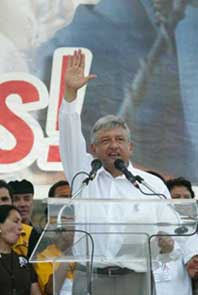
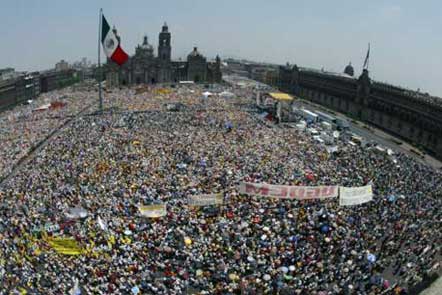
Here is the
political pressure the GEM is succumbing to: hundreds of thousands of
PRD supporters filled
Mexico City's Zócalo in April 2005 to protest removal of AMLO’s
executive immunity. GEM joined demos
with leaflet “Down with the Lifting of López Obrador’s
Immunity!” Grupo Internacionalista said demos
were political support for López Obrador, not defense of
democratic rights. AMLO’s
immunity was
lifted but he still
ran for president. (Photos: María Luisa Severiano and
María Meléndrez Parada/La Jornada)
Did the GI “reject
the struggle for the defense of democratic demands”? Not at all. We
said that
we defended the right of any party to present any candidate it wanted,
but that
was not what was going on here. We pointed out that executive immunity
is an anti-democratic
guarantee of impunity for the capitalist rulers, one that had been used
by the
authors of the 1968 and 1971 massacres, and that this is quite distinct
from
parliamentary immunity, which protects legislators from arbitrary
actions by
those very same rulers. The GEM responds by saying: “We do not take a
position
on such precepts of bourgeois legislation in the abstract, but rather
based on
the interest of the working class in each concrete
case.” In
other words, they are not acting on a matter of principle but of
political
calculation, and what they see as the “interest of the working class”
is that
large numbers of workers supported AMLO as their candidate. So the GEM
gave
AMLO backhanded support in the guise of defending his democratic rights.
In any case, the verdict on
this episode is in: López Obrador’s immunity was lifted, yet
this did not
prevent him from running in the July 2 election as the candidate of
the PRD for
president. Case closed.
Rearguard of the
Popular
Front or Vanguard of the Proletariat
Over the last several
years, in reaction to the counterrevolutionary destruction of the
Soviet Union,
the SL/U.S. and the other components of the ICL have turned sharply to
the
right and renounced a series of central Trotskyist programmatic
positions. An
important aspect of these revisions is that they take place, just when
the
issues become hot.
It is a fundamental precept
of Leninism, that in an imperialist war revolutionaries stand for the
defeat
“their own” imperialist bourgeoisie. In the United States, the SL for
years
called to “Defeat U.S. Imperialism!” notably in the Persian Gulf War of
1990-91. But amid the “anti-terrorist” war hysteria whipped up by the
government following the 11 September 2001 attacks on the World Trade
Center
and the Pentagon, the SL/ICL dropped the call for defeat of “their own”
imperialist
bourgeoisie. On top of this, they added a sinister smear, accusing the
Internationalist Group of “anti-Americanism” – literally, “Playing the
Counterfeit Card of Anti-Americanism” – and being soft on Islamic
fundamentalism, because we upheld the Leninist program of revolutionary
defeatism toward imperialist powers engaged in colonial wars.
Similarly, ever since the
Vietnam War, the SL/U.S. had regularly called for transport workers to
“hot
cargo” (refuse to handle) war materiel during imperialist wars. They
continued
to do so up to September 2002, just as the Pentagon war machine was
going into
high gear shipping military goods to the Near East out of West Coast
ports. Yet
the minute the U.S. government slapped a Taft-Hartley injunction on the
ILWU dock
workers, alleging that a walkout could affect the war effort, the SL
abruptly
dropped the call for “hot cargoing.” After much flim-flam and accusing
the IG
of “rrrevolutionary phrasemongering,” they finally admitted that they
dropped
this call for proletarian action against the war, as they had earlier
dropped
the call for workers strikes against the war, blaming it on the
backward
consciousness of the workers.
In Mexico, we have pointed
out that the GEM had called since its inception in 1990 to break with
the
popular front around the PRD. But after expelling youth cadres in late
1996 who
subsequently founded the Grupo Internacionalista, suddenly in May 1997
the GEM
declared that there was no popular front in Mexico. Not coincidentally,
this
discovery took place just as the PRD was about to win the elections for
the
government of the Federal District. The GI published an open letter to
the GEM,
titled: “To Fight the Popular Front, You Have to Recognize That It
Exists.”
Amid the wave of popular support for the PRD, the GEM didn’t want to
fight for
the workers’ organizations to break from the popular front. And last
year,
responding to the groundswell of support for presidential hopeful
López Obrador
in the “hip” Mexico City petty-bourgeoisie it orients to, the GEM
hitched its
wagon to the popular front in the name of “defending democratic rights”
when no
democratic right had been attacked.
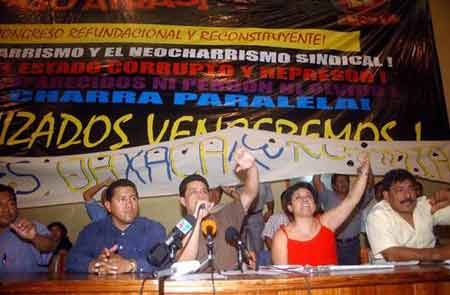 Which
side are you on?
GEM calls to “defend” SNTE while teachers
of Oaxaca Section 22 SNTE/CNTE are fighting against charro (corporatist)
national SNTE, which opposes strike. Below: Union ranks vote Sept. 27
to
continue strike. (Photos: Guillermo Ogam/Notimex and Marco
Ugarte/AP)
Which
side are you on?
GEM calls to “defend” SNTE while teachers
of Oaxaca Section 22 SNTE/CNTE are fighting against charro (corporatist)
national SNTE, which opposes strike. Below: Union ranks vote Sept. 27
to
continue strike. (Photos: Guillermo Ogam/Notimex and Marco
Ugarte/AP)
Today, the issue of
corporatist unionism in Mexico is a burning question. The
PRI-government
monolith has cracked, right-wing clericalists are in power and the
bureaucrats
who were cogs in this apparatus for state control of labor are flailing
about.
Some (like the SNTE’s “moral leader” Gordillo) have cast their lot with
the
PAN’s Fox and Calderón, others (like the dynastic head of the
SNTMMRM, Gómez
Urrutia) have made timid criticisms of the bosses, and still others
(like Vega
Gallina of the SNTSS) have gone over the PRD. At the same time, the CTM
is
headed by Josaquín Gamboa Pascoe, who is not just any old
corporatist labor boss
but headed the gang of pistoleros that under the orders of the
eternal
CTM chief Fidel Velázquez destroyed the combative union at the
Pascual bottling
plant by gunning down union militants. The Congreso de Trabajo (CT),
the
umbrella group for the corporatist labor groups, meanwhile, is led by
Víctor
Flores Morales, who presided over the destruction of his own union and
the
firing of tens of thousands of railroad workers, while growing rich off
proceeds of the privatization of the nationalized railways.
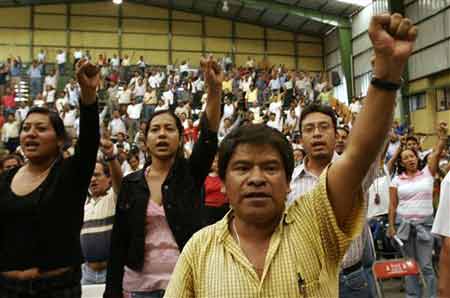 In
the middle of this
agitated situation, miners and steel workers strike against government
intervention. The corporatist “union” chief sends them back after three
days,
leaving the militant locals to strike alone for months. The Cananea
strike
loses, the Sicartsa strike wins, but no thanks to the SNTMMRM, which
didn’t
lift a finger to aid them. The Oaxaca teachers then undertake a
militant strike
which turns into a generalized revolt of the poor, indigenous and
working
people of the entire state. Now is the time to wage an aggressive
campaign to
definitively bring down the crumbling corporatist edifice and build
genuine
class-struggle unions, as the Grupo Internacionalista has been
insistently
calling for.
In
the middle of this
agitated situation, miners and steel workers strike against government
intervention. The corporatist “union” chief sends them back after three
days,
leaving the militant locals to strike alone for months. The Cananea
strike
loses, the Sicartsa strike wins, but no thanks to the SNTMMRM, which
didn’t
lift a finger to aid them. The Oaxaca teachers then undertake a
militant strike
which turns into a generalized revolt of the poor, indigenous and
working
people of the entire state. Now is the time to wage an aggressive
campaign to
definitively bring down the crumbling corporatist edifice and build
genuine
class-struggle unions, as the Grupo Internacionalista has been
insistently
calling for.
So what does the GEM do?
While complaining that the GI has “dedicated pages upon two-column
pages to
documenting the betrayals of the past and present bureaucracies of the
miners
union” (none of which they deny), the GEM “defends” the SNTMMRM without
a word
of criticism of the government-imposed labor boss Gómez
Urrutia. While
ridiculing the GI’s call for a national strike against the murderous
government, the only action the GEM actually advocated was the phony
“national
work stoppage” for June 28 that was bandied about by the CTM/CT tops
only to be
called off, as they always do, saying the timing (right before the July
2
election) was not “opportune”!
And then these
pseudo-Trotskyists denounce the GI for saying that the SNTE is an
instrument of
the class enemy for controlling labor precisely at the moment when this
apparatus is doing its level best to bust the Oaxaca teachers strike,
while
CTM/CROC gunmen are murdering strikers. These “CTM socialists” are now
effectively apologizing for death squads.
When challenged on this,
GEM/ICL cadres have responded (a) that Stalin killed a lot of
communists, but
that didn’t mean that the Soviet Union ceased to be a workers state;
and (b)
that the CROC “unionists” shooting Oaxaca strikers had “capitalist
consciousness”! No kidding. They have “capitalist consciousness”
because they
are the armed fist of the bourgeoisie, just as much as the cops they
rode with
in the “convoy of death.”
And yes, Stalin killed
several million communists, but the USSR remained a bureaucratically
degenerated workers state because it rested on the proletarian economic
basis
of collectivized property. The CTM/CT/SNTE and the rest of the
corporatist
apparatus do not rest on workers organizations, they rest on the capitalist
state, which directly provides most of their finances, while
imposing and
deposing their leaders at will, and dispatching their goon squads to
engage in
strikebreaking at gunpoint.
In making an analogy
between the Soviet Union and a workers union, Trotsky wrote of the
misleaders
the American Federation of Labor (AFL) in the late 1930s, contrasting
union
misleaders who sell out strikes to scabherders who break strikes:
“The class character of
the state is determined by its relation to the forms of property in the
means
of production. The character of a workers’ organization such as a trade
union
is determined by its relation to the distribution of national income.
The fact
that [AFL leader] Green and Company defend private property in the
means of
production characterizes them as bourgeois. Should these gentlemen in
addition
defend the income of the bourgeoisie from attacks on the part of the
workers;
should they conduct a struggle against strikes, against the raising of
wages,
against help to the unemployed; then we would have an organization of
scabs,
and not a trade union. However, Green and Company, in order not to lose
their
base, must within certain limits lead the struggle of the workers for
an
increase – or at least against a diminution – of their share of the
national
income.”
–Leon Trotsky, “Not a
Workers’ and Not a Bourgeois State?” (November 1937)
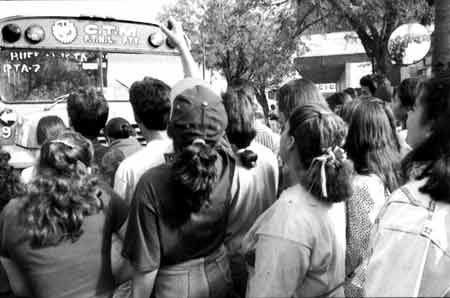 CTM scabherders: In
April 1994, women workers at SONY plant (Magnéticos de
México) in Nuevo Laredo went on strike for union democracy.
After CTM “union” boss sent police to beat strikers, the CTM
tried to break strike by busing in scabs. Three hundred strikers
blocked them (see photo). At the time, when it stood for
authentic Trotskyism, the ICL/GEM wrote: “Key is throwing off the stranglehold of the
corporatist CTM ‘unions’ which are directly integrated into the
capitalist ruling party and the elaborate ‘conciliation and arbitration’ mechanisms of state control.... [T]he Grupo
Espartaquista de México put forward a program to elect workers committees independent of
the bourgeois parties, including Cárdenas’ PRD – to break
the corporatist shackles of the CTM (which acts as labor cops
for the PRI) on the working class” (Workers
Vanguard, 24 February 1995). Today, revisionist ICL/GEM says CTM and
other corporatist federations are legitimate unions. (Photo:
Fred Chase/Impact Visuals)
CTM scabherders: In
April 1994, women workers at SONY plant (Magnéticos de
México) in Nuevo Laredo went on strike for union democracy.
After CTM “union” boss sent police to beat strikers, the CTM
tried to break strike by busing in scabs. Three hundred strikers
blocked them (see photo). At the time, when it stood for
authentic Trotskyism, the ICL/GEM wrote: “Key is throwing off the stranglehold of the
corporatist CTM ‘unions’ which are directly integrated into the
capitalist ruling party and the elaborate ‘conciliation and arbitration’ mechanisms of state control.... [T]he Grupo
Espartaquista de México put forward a program to elect workers committees independent of
the bourgeois parties, including Cárdenas’ PRD – to break
the corporatist shackles of the CTM (which acts as labor cops
for the PRI) on the working class” (Workers
Vanguard, 24 February 1995). Today, revisionist ICL/GEM says CTM and
other corporatist federations are legitimate unions. (Photo:
Fred Chase/Impact Visuals)
But, in fact,
the CTM, CROC, CT, SNTE and the rest of the corporatist labor
apparatuses
literally conduct struggles against strikes and against raising wages,
while
organizing scabs, murdering union militants and exploiting the labor of
contract workers while their leaders not only enrich themselves with
graft but
become actual capitalists. In short, by Trotsky’s criteria and a
Marxist,
materialist analysis, these are literally “organizations of scabs,” not
workers
unions.
The GEM outrageously
repeats its charge that the Grupo Internacionalista “supported Fox’s
plans” by
refusing to make common cause with the pro-PRD rallies last year, as
the GEM
did in the name of defending democratic rights. We know this smear
well.
These are the same charges that were hurled by the Stalinists against
the
Trotskyists during the Spanish Civil War, for refusing to give
political
support to the bourgeois Republican politicians. The GEM absurdly
pretends it
is swimming against the stream because it maintains a verbal
independence from
the PRD, while in fact tailing after it. It writes:
“On July 30, a small team
of Spartacists was distributing their Trotskyist press … among two
million
ardent supporters of López Obrador. When he began to speak (on
the giant
screens), one of the demonstrators got up on a lamppost and yelled at
the
others: ‘Be quiet, the jefe (boss) is speaking!’ There followed
almost
absolute silence, only interrupted by the cheers during his speech.
This should
give an idea what it means in reality to ‘swim against the stream’….”
This certainly
gives an idea of the political pressure the GEM is capitulating to,
which is
real indeed. But in distributing leaflets and selling papers with
headlines on
“The Attacks of the PAN,” these centrists are not swimming against the
stream but going with
the flow of the AMLO popular front.
While the GEM uncritically tails after the corporatist union bureaucrats and “defends” the PRD presidential candidate against future threats to democratic rights, and the SL/U.S. only reluctantly agrees to endorse a New York City demonstration to defend Oaxaca teachers, the sections of the League for the Fourth International (Grupo Internacionalista/México, Liga Quarta-Internacionalista do Brasil and Internationalist Group/U.S.) have actively fought to organize proletarian solidarity with Mexican workers under the blows of state repression. Emphasizing the need for international socialist revolution, the IG speaker at the September 21 NYC demonstration noted that this is the centenary of the Cananea miners strike which was the joint effort of revolutionary Mexican and U.S. workers. As Cananea 1906 served a precursor of the 1910-17 Mexican Revolution, the 2006 Oaxaca strike can be a spark for workers revolution on both sides of the border. The key, today and yesterday, is revolutionary leadership. n
To contact the Internationalist Group and the League for the Fourth International, send e-mail to: internationalistgroup@msn.com